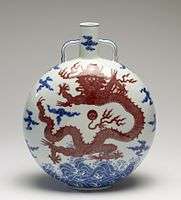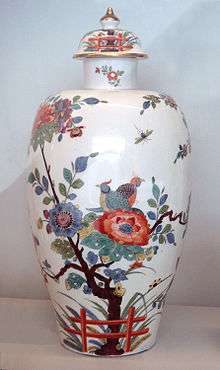Blue and white pottery
_imperial_blue_and_white_vase%2C_from_The_Metropolitan_Museum_of_Art._%E6%98%8E%E5%AE%A3%E5%BE%B7_%E6%99%AF%E5%BE%B7%E9%8E%AE%E7%AA%AF%E9%9D%92%E8%8A%B1%E8%B2%AB%E8%80%B3%E7%93%B6%2C_%E7%BA%BD%E7%BA%A6%E5%A4%A7%E9%83%BD%E5%8D%9A%E7%89%A9%E9%A6%86_.jpg)
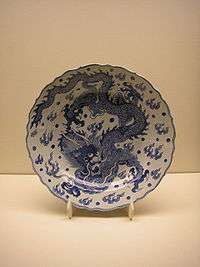
"Blue and white pottery" (Chinese: 青花; pinyin: qīng-huā; literally: "Blue flowers") covers a wide range of white pottery and porcelain decorated under the glaze with a blue pigment, generally cobalt oxide. The decoration is commonly applied by hand, originally by brush painting, but nowadays by stencilling or by transfer-printing, though other methods of application have also been used.
Blue and white decoration first became widely used in Chinese porcelain in the 14th century, after the cobalt pigment for the blue began to be imported from Persia. A style of decoration based on sinuous plant forms spreading across the object was perfected, and most commonly used. It was widely exported, and inspired imitative wares in Islamic ceramics and later European tin-glazed eathenware such as Delftware and after the techniques was discovered in the 18th century, European porcelain. Blue and white pottery in all these traditions continues to be produced, most of it copying earlier styles.
Origin and development

Cobalt blue was first used in decorating Islamic pottery, especially in Persia, where the main source was located in mines near Kashan.[2]
Tang and Song blue-and-white
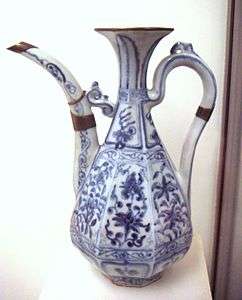
The first Chinese blue and white wares were as early as the ninth century in Henan province, China; although only shards have been discovered. Tang period blue-and-white is even rarer than Song blue-and-white and was unknown before 1985.[3] The Tang pieces are not porcelain however, but rather earthenwares with greenish white slip, using cobalt blue pigments.[3] The only three pieces of complete "Tang blue and white" in the world were recovered from Indonesian Belitung shipwreck in 1998 and later sold to Singapore.[4] It appears that the technique was thereafter forgotten for some centuries.[2]
In the early 20th century the development of the classic blue and white Jingdezhen ware porcelain was dated to the early Ming period, but consensus now agrees that these wares began to be made around 1300-1320, and were fully developed by the mid-century, as shown by the David Vases dated 1351, which are cornerstones for this chronology.[5] There are still those arguing that early pieces are mis-dated, and in fact go back to the Southern Song, but most scholars continue to reject this view.[6]
14th century development
In the early 14th century mass-production of fine, translucent, blue and white porcelain started at Jingdezhen, sometimes called the porcelain capital of China. This development was due to the combination of Chinese techniques and Islamic trade.[7] The new ware was made possible by the export of cobalt from Persia (called Huihui qing, 回回青, "Islamic blue"), combined with the translucent white quality of Chinese porcelain.[7] Cobalt blue was considered as a precious commodity, with a value about twice that of gold.[7] Motifs also draw inspiration from Islamic decorations.[7] A large portion of these blue-and-white wares was then shipped to Southwest-Asian markets through the Muslim traders based in Guangzhou.[7]
Chinese blue and white porcelain was once-fired: after the porcelain body was dried, decorated with refined cobalt-blue pigment mixed with water and applied using a brush, coated with a clear glaze and fired at high temperature. From the 16th century, local sources of cobalt blue started to be developed, although Persian cobalt remained the most expensive.[7] Production of blue and white wares has continued at Jingdezhen to this day. Blue and white porcelain made at Jingdezhen probably reached the height of its technical excellence during the reign of the Kangxi Emperor of the Qing dynasty (r. 1661–1722).
Evolution of blue and white ware
14th century
The true development of blue and white ware in China started with the first half of the 14th century, when it progressively replaced the century-long tradition of bluish-white ware, or Qingbai. The main production center was in Jingdezhen, Jiangxi Province.
-

Early blue and white ware, first half of 14th century, Jingdezhen.
-

Blue and white vase from the Yuan dynasty (1271-1368), Jingdezhen, unearthed in Jiangxi Province.
-
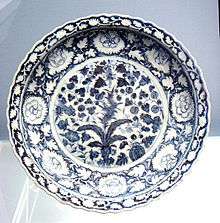
Blue and white plate, Jingdezhen, Yuan dynasty (1271-1368).
-

Blue and white jar, Jingdezhen, Yuan dynasty (1271-1368).
15th century
With the advent of the Ming dynasty in 1368, blue and white ware was shunned for a time by the Court, especially under the Hongwu and Yongle Emperors, as being too foreign in inspiration.[7] Blue and white porcelain however came back to prominence with the Xuande Emperor, and again developed from that time on.[7]
-
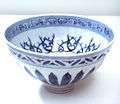
Blue and white bowl, Jingdezhen, Ming Yongle (1403-1424).
-

Blue and white jar, Jingdezhen, Ming Yongle (1403-1424).
-
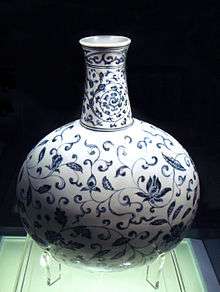
Blue and white vase, Jingdezhen, Ming Yongle (1403-1424).
-
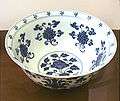
Blue and white, Ming Xuande (1426-1435).
16th century
Some blue and white wares of the 16th century were characterized by Islamic influences, such as the ware under the Zhengde Emperor (1506–1521), which sometimes bore Persian and Arabic script,[8] due to the influence of Muslim eunuchs serving at his court.
-

Blue and white porcelain box, with Arabic and Persian inscriptions, Zhengde (1506-1521).
-
Blue and white vase, Ming Wanli (1573-1620).
-

Blue and white jar, Ming Wanli (1573-1620).
17th century
During the 17th century, numerous blue and white pieces were made as Chinese export porcelain for the European markets. European symbols and scenes coexisted with Chinese scenes for these objects.[8] In the 1640s, rebellions in China and wars between the Ming dynasty and the Manchus damaged many kilns, and in 1656–1684 the new Qing Dynasty government stopped trade by closing its ports. Chinese exports almost ceased and other sources were needed to fulfill the continuing Eurasian demand for blue and white. In Japan, Chinese potter refugees were able to introduce refined porcelain techniques and enamel glazes to the Arita kilns. From 1658, the Dutch East India Company looked to Japan for blue-and-white porcelain to sell in Europe. Initially, the Arita kilns like the Kakiemon kiln could not yet supply enough quality porcelain to the Dutch East India Company, but they quickly expanded their capacity. From 1659–1740, the Arita kilns were able to export enormous quantities of porcelain to Europe and Asia. Gradually the Chinese kilns recovered, and by about 1740 the first period of Japanese export porcelain had all but ceased.[9] From about 1640 Dutch Delftware also became a competitor, using styles frankly imitative of the East Asian decoration.
-

Blue and white export porcelain, Qing Kangxi era, (1690-1700).
-

Export porcelain vase with European scene, Qing Kangxi era, (1690-1700).
-
.gif)
Japanese Arita ware blue and white underglaze porcelain tankard with Dutch silver lid of 1690
-
Delftware bottle, c. 1675, tin-glazed earthenware
18th century
In the 18th century export porcelain continued to be produced for the European markets.[8] As a result of the work of Francois Xavier d'Entrecolles however, an early example of industrial spying in which the details of Chinese porcelain manufacture were transmitted to Europe, Chinese exports of porcelain soon shrank considerably, especially by the end of the reign of the Qianlong Emperor.[10]
-

Blue and white export plate, Jingdezhen, Qing Qianlong (1736-1795).
-

Blue and white export porcelain (18th century).
Influences
Influences on Islamic pottery
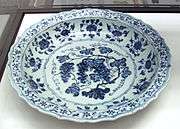
Right image: Stone-paste dish with grape design, Iznik, Turkey, 1550-70. British Museum.
Chinese blue and white ware became extremely popular in the Middle-East from the 14th century, where both Chinese and Islamic types coexisted.[11]

From the 13th century, Chinese pictorial designs, such as flying cranes, dragons and lotus flowers also started to appear in the ceramic productions of the Near-East, especially in Syria and Egypt.[12]
Chinese porcelain of the 14th or 15th century was transmitted to the Middle-East and the Near East, and especially to the Ottoman Empire either through gifts or through war booty. Chinese designs were extremely influential with the pottery manufacturers at Iznik, Turkey. The Ming "grape" design in particular was highly popular and was extensively reproduced under the Ottoman Empire.[12]
Influences on European porcelains
Early influences

Chinese blue-and-white ware were copied in Europe from the 16th century, with the faience blue-and-white technique called alla porcelana. Soon after the first experiments to reproduce the material of Chinese blue-and-white porcelain were made with Medici porcelain. These early works seem to be mixing influences from Islamic as well as Chinese blue-and-white wares.[13]
-
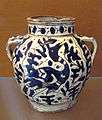
Blue relief vase, Florence, 2nd half of 15th century.
-
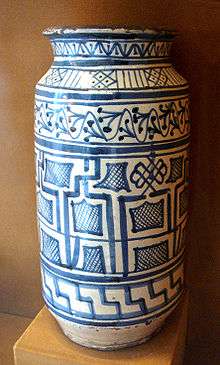
Blue-and-white faience albarello with Pseudo-Kufic designs, Tuscany, 2nd half of 15th century.
Direct Chinese imitations

By the beginning of the 17th century Chinese blue and white porcelain was being exported directly to Europe. In the 17th and 18th centuries, Oriental blue and white porcelain was highly prized in Europe and America and sometimes enhanced by fine silver and gold mounts, it was collected by kings and princes.


The European manufacture of porcelain started at Meissen in Germany in 1707. The detailed secrets of Chinese hard-paste porcelain technique were transmitted to Europe through the efforts of the Jesuit Father Francois Xavier d'Entrecolles between 1712 and 1722.[14]
The early wares were strongly influenced by Chinese and other Oriental porcelains and an early pattern was blue onion, which is still in production at the Meissen factory today. The first phase of the French porcelain was also strongly influenced by Chinese designs. Early English porcelain wares were also influenced by Chinese wares and when, for example, the production of porcelain started at Worcester, nearly forty years after Meissen, Oriental blue and white wares provided the inspiration for much of the decoration used. Hand-painted and transfer-printed wares were made at Worcester and at other early English factories in a style known as Chinoiserie. Many other European factories followed this trend. In Delft, Netherlands blue and white ceramics taking their designs from Chinese export porcelains made for the Dutch market were made in large numbers throughout the 17th Century. Blue and white Delftware was itself extensively copied by factories in other European countries, including England, where it is known as English Delftware.
Patterns

The plate shown in the illustration (left) is decorated with the famous willow pattern and was made by Royal Stafford; a factory in the English county of Staffordshire. Such is the persistence of the willow pattern that it is difficult to date the piece shown with any precision; it is possibly quite recent but similar wares have been produced by English factories in huge numbers over long periods and are still being made today. The willow pattern, said to tell the sad story of a pair of star-crossed lovers, was an entirely European design, though one that was strongly influenced in style by design features borrowed from Chinese export porcelains of the 18th Century. The willow pattern was, in turn, copied by Chinese potters, but with the decoration hand painted rather than transfer-printed.
See also
- Chinese ceramics
- Blanc-de-Chine
- Chinoiserie
- Meissen porcelain
- Delftware
- English Delftware
- Joseon white porcelain
- Willow pattern
- Orientalism in early modern France
Notes
- ↑ Met description
- 1 2 Medley, 177
- 1 2 Song blue-and-white was rare enough, but Tang blue-and-white was unheard of" in Chinese glazes: their origins, chemistry, and recreation Nigel Wood p.97
- ↑ curating the oceans and Belintung shipwreck
- ↑ Medley, 177; Kessler, 9
- ↑ Kessler is a book devoted to arguing for earlier dates, as summarized in the Introduction. For earlier 20th century views, see p. 3 in particular. See Medley, p. 176 for a rejection of such dates.
- 1 2 3 4 5 6 7 8 Finlay, p.158ff
- 1 2 3 Musée Guimet permanent exhibit
- ↑ Ford & Impey, 126-127
- ↑ China's last empire: the great Qing William T. Rowe, Timothy Brook p.84
- ↑ Medieval Islamic civilization: an encyclopedia by Josef W. Meri, Jere L. Bacharach p.143
- 1 2 Notice of British Museum "Islamic Art Room" permanent exhibit.
- ↑ Western Decorative Arts National Gallery of Art (U.S.), Rudolf Distelberger p.238
- ↑ Baghdiantz McCabe, Ina (2008) Orientalism in Early Modern France, ISBN 978-1-84520-374-0, Berg Publishing, Oxford, p.220ff
References
- Finlay, Robert, 2010, The Pilgrim Art. Cultures of Porcelain in World History. University of California Press ISBN 978-0-520-24468-9
- Ford, Barbara Brennan, and Oliver R. Impey, Japanese Art from the Gerry Collection in The Metropolitan Museum of Art, 1989, Metropolitan Museum of Art, fully online
- Kessler, Adam T., Song Blue and White Porcelain on the Silk Road, 2012, BRILL, ISBN 9789004231276
- Medley, Margaret, The Chinese Potter: A Practical History of Chinese Ceramics, 3rd edition, 1989, Phaidon, ISBN 071482593X
External links
| Wikimedia Commons has media related to Blue and white porcelain. |
- Chinese Blue and White Porcelain at China Online Museum
- underglazedblue - Unique content and discussion on porcelain and collecting.
- A Handbook of Chinese Ceramics from The Metropolitan Museum of Art

_in_Solos-Thuluth_calligraphy%2C_China%2C_Ming_dynasty%2C_Zhengde_period%2C_1506-1521_AD%2C_underglaze_painted_porcelain_-_Aga_Khan_Museum_-_Toronto%2C_Canada_-_DSC06903.jpg)
